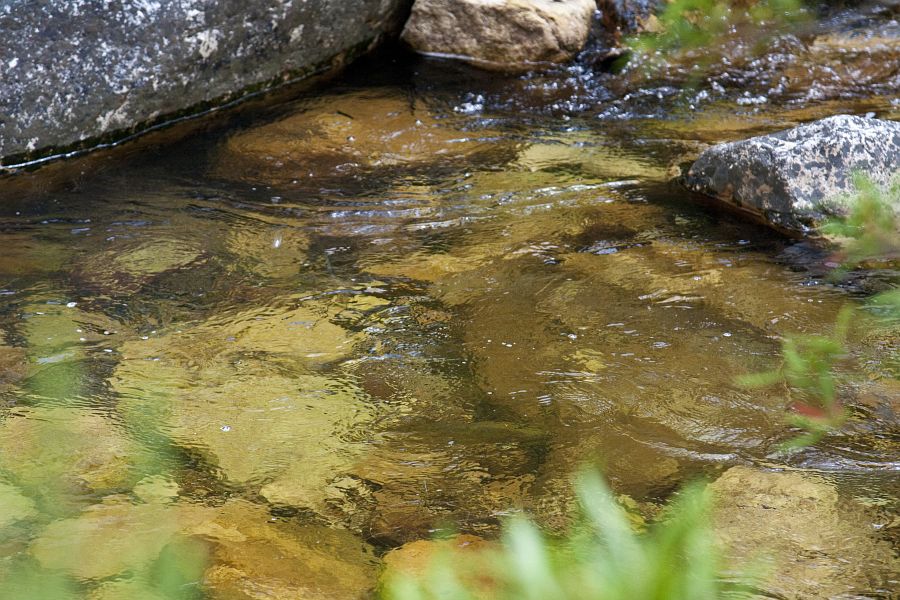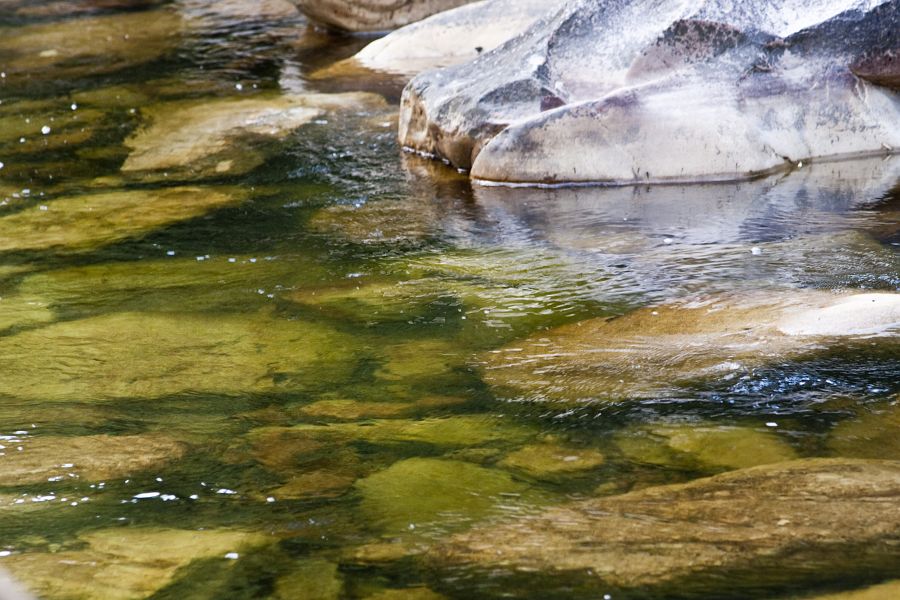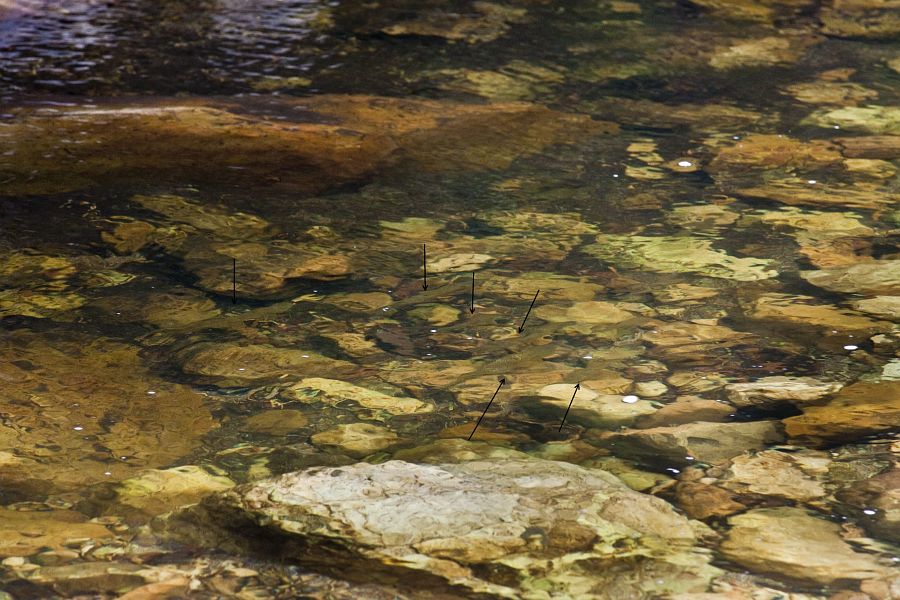May I suggest that you scroll through all the sequences right to the end before looking at any of the answers? Then scroll through all the answers. Then try the exercise all over again from the first picture on.
WALKING ALONG A STREAM
Walking along a riverbank I always keep an eye out for fish. The added height gives you an advantage and the bank side vegetation conceals you. In this sequence of pictures I spotted a very nice fish that was pretty well concealed as you will see. The only reason I picked him up was that he moved as I was glancing into the run. This particular trout beautifully illustrates the point I once made that trout in clear water, certainly in the Western Cape streams, are often no more than a ‘twist of barley’. It’s what you see when you first pour a dash of say cola tonic, or any other similar syrupy cordial, into a glass of ginger ale. There’s a brief moment when the cola tonic is visible as a sort of twirling, barley-coloured linear shape before it mixes away. The same analogy would apply to say pouring limejuice into a glass of soda water only the colours would be different. So study the next three pictures and see if this cryptic fish becomes visible to you. A clue in these pictures is that the current is moving from the left to the right of the frame so the fish is facing left. If you don’t see him, go to the end of the page for the peep at the answer taken from the final of the three frames.



BOLD TROUT
Trout boldly sitting out in give-away places are almost always in feeding lies and so are very catchable. Why they sometimes choose to sit over pale stones like this and not darker ones is surprising, but it has to do with the dynamics of the currents going through a run on a given day at a given water level and thus it is dictated by insect drift. We put a size 16 CDC midge dry fly over this fish using a long 7X tippet and hooked him first cast. I’ll be surprised if you don’t spot him straight away, but if not, go to the answer section.


‘HERDING’ TROUT
In low water fish at the tail of a run are wary and even if you stalk them and don’t spook them outright they just become aware something is not right and often slowly move into deeper water. The fish in the two pictures below were not spooked in the true sense of the word, but they were aware something wasn’t right and were cagey. They kept moving into deeper water where they appeared to congregate. We gave them plenty of time to settle, put a few casts over them, but they were too wary to feed. See if you can spot all 6 in the first picture and all 5 in the second, though the fish furthest right in this picture shows only a tail and part of its body.


A REALLY DIFFICULT SIGHTING
This fish was a lucky spot in that he moved just as I got to the run. In the first picture look for the draped shadow. Note the fish is out of the riffle water so will obviously be very spooky. We caught him on a very small dry fly after finding he was feeding on really tiny mayflies. By the time you get to the last picture in this sequence the fish is obvious. But study the first picture really well before going to the answer at the end.



TROUT LYING DEEP APPEARS ONLY WHEN HE LIFTS TO FEED
In the next series of pictures – also taken from the riverbank – the trout is at first deep then becomes visible as it lifts to feed. Having seen the answer at the end, go back to all these pictures and see just how cryptic this fish is. Again, in real life the spotting would be easier because of the fish’s occasional movements.



GLARE ND REFLECTIONS
I did everything I could twisting the polariser on the front of the lens to get rid of the glare and reflection of the big rock on the right of this pool. Nothing worked on it because the sun was straight ahead when polarisers battle. Fortunately the trout was out of the area covered in reflections where I would have been blinded. Had this been the case I might have stalked this run just behind the bank side vegetation to have a look into the water at 90 degrees to the suns rays.
Don’t worry too much if you can’t find the fish in the first picture. It is a really difficult spot. But as we zoom in it becomes a straight forward sighting. The answer to the first picture will be at the end. Note how this fish changes its position, slowly sinking back in the run.




TWO FOR THE PRICE OF ONE
In the first picture there’s a trout holding deep and it’s very hard to see. In the second picture as I was photographing it a brown trout swam into view, obviously feeding. You will see a line going out over the water presenting a dry fly to the brown – which he inspected but repeatedly refused. You will see the brown to the left of the fly with the deeper-holding trout now far more obvious. In the next picture the brown swims right up to the fly and refuses it. Following this incident the brownie then took up the most unusual position in shallow water just off the point of the red-coloured rock. He stayed feeding here for a long while. We got a fly over him but miss-timed the strike by a nano-second (too early) and he was gone!





NOT SO STRAIGHT FORWARD IN WIND
Notice how the trout is almost invisible in the first picture but plain as the nose on your face in the next two. The reason for this is the wind drops and for a moment the water surface is smoother. It is most smooth in the last of the three images.



DIFFICULT TROUT FOR SOME REASON WE NEVER FOUND OUT
In the first picture Stanton Hector is preparing to cast at a fish close by in the run ahead of him. Notice his low profile. You can actually see the fish, but it won’t be easy on your pc screen, so I will provide an answer at the end. During the sequence the trout rose confidently as you will see in one of the images, but we could not get a take in 30 odd casts using a big spread of patterns. I later thought we maybe needed a black micro-ant pattern, but who knows.



A TEASER
Not that easy a sighting this one, but there is a lovely shadow as a clue.

LINING UP
I have taken a picture of a trout lying in this exact run and posted it in a previous edition of this series. In the image below, two large trout have taken up position. It’s a scene reminiscent of fish in a spring creek or an English chalkstream. I’ll leave you to find them.

ANSWERS
















